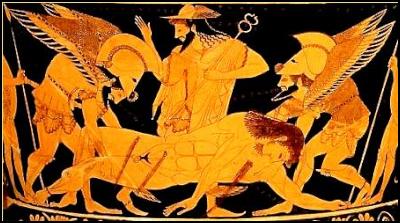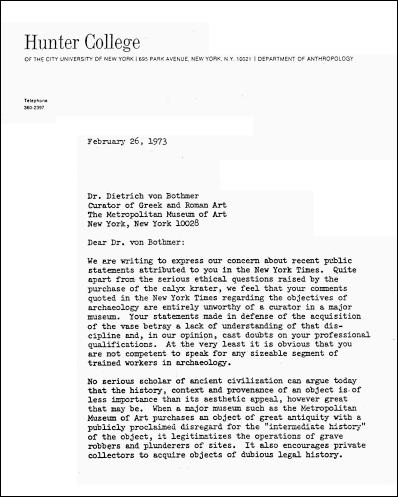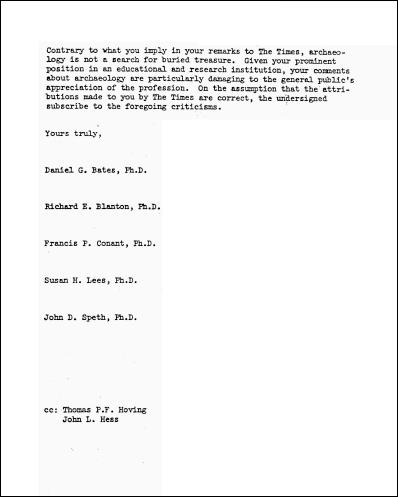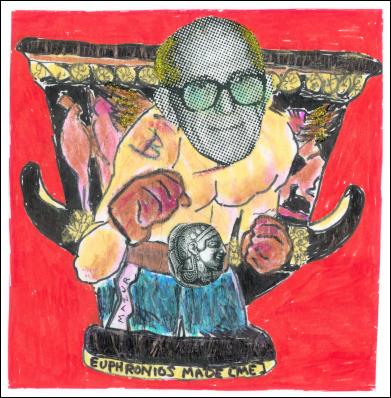"Bully Bob" Hecht And The Euphronios Questions
"Bully Bob" Hecht & The Unanswered Euphronios Questions
By Suzan Mazur
Related Stories:
A Preview Of Bob Hecht's Memoirs
Bob Hecht, The Younger
The Provenance Of Bob Hecht
Deeper Into The Dillon-Euphronios Nexus
Antiquities Whistleblower Oscar White Muscarella
"Bully Bob" Hecht is best known for escorting Italy's priceless Sarpedon Euphronios vase to the US in 1972 and selling it for personal profit to a private museum that gets public funding -- the Metropolitan Museum of Art; his price was $1million. Hecht is also known for his threatening fist, including an attempted assault on this writer.
The two episodes are not unrelated. They are facets of Hecht's ruthlessness, of his violent history.
Now indicted by the Italian government for trafficking in stolen antiquities -- 94 are listed -- and on trial in Rome, the 87-year old remains at-large on Manhattan's Upper East Side (defendants are not required to attend their own trials under Italian law), where he continues to charm news organizations like his hometown paper, the Baltimore Sun.
Hecht and the Sun recently entertained one another at Park Avenue's Union Club. The paper assigned a reporter to the story ("Shadows in a Tomb" 6/18/6) who had no background in antiquities and then quoted Hecht saying: "There is no concrete proof that these things were illegally excavated."
The Sun headlined the story: "For years, Robert E. Hecht sold many of Italy's national treasures. The question is: Was he stealing it?"
It then wrapped up the piece with an astonishing statement from Baltimore's Walters Art Gallery director Gary Vikan:
"I don't think there's a museum in this country that doesn't have something that Bob Hecht sold them. . . . In some respects, I think it's absolutely fair to say that thanks to Bob Hecht there are many of us in this world who are able to see works of art that reflect our shared heritage."
Thanks to Bob?
-- What of the serious charges brought against Hecht by Italian prosecutors? --trafficking in stolen antiquities, i.e., plunder, "rape of the Earth" -- as Met Ancient Near East expert Oscar Muscarella so aptly puts it .
-- What of Hecht's assault on classmates at Haverford College reported by the late John L. Hess in The Grand Acquisitors?
-- And at the American Academy in Rome? Former Met director Tom Hoving, who bought the Sarpedon Euphronios bowl from Hecht in 1972, writes this in his artnet.com "Hot Pot" series:
"I knew him [Hecht] from 1953, when I was living in Rome, when he'd left the prestigious American Academy because he threatened a colleague for having made eyes at his wife."
-- Then there's Hecht's attempted assault on me at an Upper East Side art exhibition for citing his arrest in Turkey over looted antiquities in my coverage for The Economist of the Hunt-Sotheby's auction -- "Coining it in" 6/23/90:
"Mr. Hoving declined [the Euphronios wine cup], because he had just paid $1m for a Euphronios bowl which the Italian government claimed had been looted from an Etruscan tomb. Mr. Hecht said he had bought it from a Lebanese businessman whose father had acquired it in a trade for some coins; but he was arrested in both Italy and Turkey on charges of buying looted antiquities. Mr. Hoving did not wish to burn his fingers again."
Hecht, more than a year later, was still agitated over his Economist "outing", mentioning me in his August 27, 1991 handwritten letter to Turkish journalist Ozgen Acar: A Preview Of Bob Hecht's Memoirs .
-- Peter Watson picks up on the trail of Hecht's arrest in his new book, The Medici Conspiracy:
"At the time he [Hecht] was persona non grata in Turkey following a scandal in which, on an internal flight from Izmir to Istanbul, he had taken out some ancient gold coins to examine them. . . . On arrival, police were waiting for Hecht, arrested him, and seized the coins, which they discovered had been illegally excavated. . . . He had also been arrested in Italy in the early 1960s. . .but acquitted."
-- Watson also highlights Hecht's treachery with a story in the book about Zurich art dealer Frida Tchacos who told Italian prosecutor Paolo Ferri that antiquities dealer Robin Symes told her "Hecht was a dangerous man", and that she found Hecht "vindictive" and was "afraid of him". Watson noted other figures in the antiquities world were similarly "intimidated" by Hecht, and that Hecht threatened to expose anyone who cut in on his territory, etc.
Fortunately, Hecht's pampered lifestyle has enabled him to live to a ripe old age and he now faces his accusers. But it's unlikely he feels any remorse, as the following email to me from one of his former acquaintances reveals:
"What fuels him? My impression is that he has a Liar Button that automatically gets stepped on hard every time his vocal cords, to which it is connected, are in operation. Bob, from all the evidence that has come my way . . . is just a shifty quantity who discovered early on that he is adept at driving a brave trade with financial success by running round and round on the inaccessible fringes of legality and propriety in sophisticated and insanely clever ways --- until he gets caught, that is. It's called being a psychopath or sociopath; he has no internal restraints, compunction or capacity for remorse, let's say isn't burdened with the awful baggage of a conscience. . . Tied to this is an enormous appetite for flamboyant and stylish international living."
But Hecht is wrong about there being "no concrete proof" of illegal excavation. There is evidence: the conviction of Hecht's former antiquities partner, Giacomo Medici and others in the ring, the hoard of recovered antiquities -- some with Sotheby's tags still on them -- as well as the Met's relinquishing title to Italy of the Sarpedon Euphronios vase. The latter has seriously opened the floodgates for the return of other cultural heritage from US museums.
The fact that the Met insisted on a "no liability" clause in their February 2006 contract with the Italians is proof enough that the purchase of the vase was not made in "good faith". And it's unlikely the Met would ever have surrendered ownership of the so-called "complete" Euphronios if there were not evidence that it was plundered.
For example, there were photographs taken of the vase before final restoration that could prove whether the breaks in the bowl were ancient or modern. Experts says that while it's rare to find such objects of antiquity as the Euphronios whole, the vase fragments could have been further broken up to smuggle them following an illegal dig.
John L. Hess in Grand Acquisitors (1974) says the following about the Sarpedon Euphronios:
"The fact that the vase had been broken into many parts was significant for another reason, which up to this writing has never been publicly remarked. There are ten human figures on the krater; not one of the breaks crosses any of the ten faces. If this occurred by accident, it was almost miraculous. It would be more understandable if, as frequently happened, an experienced operator had deliberately broken up the vase to facilitate smuggling it out of Italy."
The prerestoration photos of the vase in the Met's possession "clearly indicated the contours of the fragments" noted New York Times correspondent Nicholas Gage in 1973.
The museum lent prerestoration shots to the Times. But Gage recently told me he no longer remembers who actually saw them, saying "it was 30 years ago".
The photos were supposedly then snatched back by Met director Tom Hoving who said he was concerned the Times had "radiographed copies of the photographs to Europe", that they could color the testimony of tombaroli claiming to have dug up the vase. The Times said it had not done so.
And why would it? Arthur Ochs Sulzberger, Sr., then publisher of the NYT, was on the Met's Acquisitions Committee (and later its chairman) which voted to purchase the vase from Hecht.
This may be why Hecht tried but failed to charm Nick Gage in Rome over dinner with wine rather than attack him. Gage would report Hecht's arrest in Turkey and Italy in a Times column 2/20/73, after their face-to-face interview.
But in an earlier NYT story, John Hess also cites Met curator of Greek and Roman Art, Dietrich von Bothmer, saying that although he didn't think breaks in the vase were recent -- if they were, "it would lend support to an Italian speculation that the vase had been found nearly intact and was broken to facilitate its smuggling."
Von Bothmer also admitted at the time that the vase had never been previously mentioned in any scholarly article or sales brochure.
Now, with the Italians in possession of the Sarpedon Euphronios -- though the vase remains on display at the Met until 2008 -- they can attempt to examine the breaks to determine once and for all how ancient they really are as well as demand to see the prerestoration photos (if they have not already done so).
I have telephoned the Met requesting to see shots of the unrestored vase myself and for permission to publish them, leaving messages with both the current Greek and Roman curator -- Carlos Picon, and with Dietrich von Bothmer. Von Bothmer, 34 years later is still "keeper of the museum's secrets" in his role as Distinguished Research Curator of Greek and Roman Art.
So far neither has responded.

Dietrich von Bothmer - Image Source
John Hess also reported at the time of the Euphronios affair that von Bothmer in answer to a question about whether an independent expert could check to see if the breaks were new, claimed studies carried out on the vase were already available.
But those were thermoluminescence studies done at Oxford from filings of the vase to determine the age of the pottery, not the cracks. And while modern details will "fluoresce" under black light, the ultraviolet tests carried out by the Met on the vase -- whatever the results were -- were not independently verified.
Also, von Bothmer's comment about the availability of the tests does not square off with the Met's said sudden recall of photos of the unrestored vase from the Times.
Then there was John Hess's reassignment at the NYT as food critic following his and Nick Gage's fundamentally important reporting of the Euphronios affair. . .
Gage had actually tracked down one of the tomb robbers and recorded his confession. Gage later left the Times to produce movies and write books, including the poignant Eleni, an account of his mother's torture during the Greek Civil War.
Meanwhile, the glib remarks about Bob Hecht cited above from Walters Art Gallery director Gary Vikan recall those made by Dietrich von Bothmer to the Times in 1973 in defense of his acquisition of the Sarpendon Euphronios:
Dietrich von Bothmer: "I want to know where it was made, who did it and when. . . I want to know whether it is genuine or fake. Its intermediate history is not important to archaeology. Why can't people look at it simply as archaeologists do, as an art object?"

Caption: Calyx krater painted by Euphronios, 6th century BC, currently on loan from Italy to the Met. The scene depicts the slain Lycian prince Sarpedon, son of Zeus, being carried off the Trojan battlefield by Sleep and Death.
Image Source
But more important than von Bothmer's quip to the Times is the subsequent challenge to von Bothmer from archaeology & anthropology scholars at New York's Hunter College. Their February 1973 letter follows:


Scholars' letter, see
transcript below...
"February 26, 1973Dr. Dietrich von Bothmer
Curator of Greek and Roman Art
The Metropolitan Museum of Art
New York, New York 10028Dear Dr. von Bothmer:
We are writing to express our concern about recent public statements attributed to you in the New York Times. Quite apart from the serious ethical questions raised by the purchase of the calyx krater, we feel that your comments quoted in the New York Times regarding the objectives of archaeology are entirely unworthy of a curator in a major museum. Your statements made in defense of the acquisition of the vase betray a lack of understanding of that discipline and, in our opinion, cast doubts on your professional qualifications. At the very least it is obvious that you are not competent to speak for any sizeable segment of trained workers in archaeology.
No serious scholar of ancient civilization can argue today that the history, context and provenance of an object is of less importance than its aesthetic appeal, however great that may be. When a major museum such as the Metropolitan Museum of Art purchases an object of great antiquity with a publicly proclaimed disregard for the "intermediate history" of the object, it legitimizes the operations of grave robbers and plunderers of sites. It also encourages private collectors to acquire objects of dubious legal history.
Contrary to what you imply in your remarks to The Times, archaeology is not a search for buried treasure. Given your prominent position in an educational and research institution, your comments about archaeology are particularly damaging to the general public's appreciation of the profession. On the assumption that the attributions make to you by The Times are correct, the undersigned subscribe to the foregoing criticisms.
Yours truly,
Daniel G. Bates, Ph.D.
Richard E. Blanton, Ph.D.
Francis P. Conant, Ph.D.
Susan H. Lees, Ph.D.
John D. Speth, Ph.D.cc: Thomas P.F. Hoving
John L. Hess"
 Suzan
Mazur's stories on art and antiquities have been published
in The Economist, Financial Times, Connoisseur, Archaeology
(cover) and Newsday. Some of her other reports have appeared
on PBS, CBC and MBC. She has been a guest on McLaughlin,
Charlie Rose and various Fox Television News programs.
Email: sznmzr @
aol.com
Suzan
Mazur's stories on art and antiquities have been published
in The Economist, Financial Times, Connoisseur, Archaeology
(cover) and Newsday. Some of her other reports have appeared
on PBS, CBC and MBC. She has been a guest on McLaughlin,
Charlie Rose and various Fox Television News programs.
Email: sznmzr @
aol.com



 DC Harding: In The Spirit Of Natural Justice
DC Harding: In The Spirit Of Natural Justice Martin LeFevre - Meditations: Animal Encounters During Meditative States
Martin LeFevre - Meditations: Animal Encounters During Meditative States Ian Powell: Gisborne Hospital Senior Doctors Strike Highlights Important Health System Issues
Ian Powell: Gisborne Hospital Senior Doctors Strike Highlights Important Health System Issues Keith Rankin: Who, Neither Politician Nor Monarch, Executed 100,000 Civilians In A Single Night?
Keith Rankin: Who, Neither Politician Nor Monarch, Executed 100,000 Civilians In A Single Night? Eugene Doyle: Writing In The Time Of Genocide
Eugene Doyle: Writing In The Time Of Genocide Gordon Campbell: On Wealth Taxes And Capital Flight
Gordon Campbell: On Wealth Taxes And Capital Flight